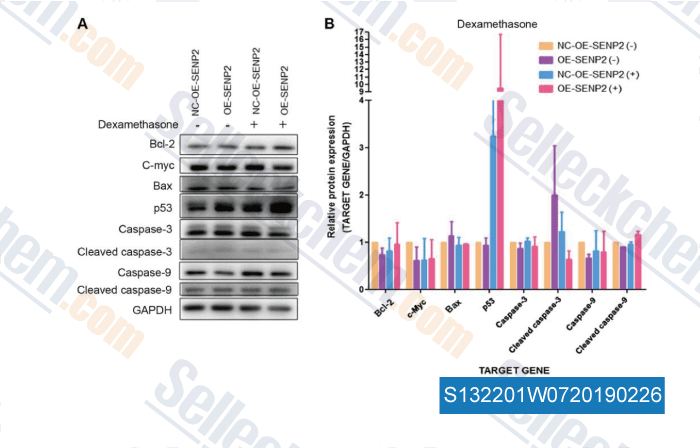|
Toll Free: (877) 796-6397 -- USA and Canada only -- |
Fax: +1-832-582-8590 Orders: +1-832-582-8158 |
Tech Support: +1-832-582-8158 Ext:3 Please provide your Order Number in the email. |
Technical Data
| Formula | C22H29FO5 |
|||
| Molecular Weight | 392.46 | CAS No. | 50-02-2 | |
| Solubility (25°C)* | In vitro | DMSO | 79 mg/mL (201.29 mM) | |
| Ethanol | 6 mg/mL (15.28 mM) | |||
| Water | Insoluble | |||
|
* <1 mg/ml means slightly soluble or insoluble. * Please note that Selleck tests the solubility of all compounds in-house, and the actual solubility may differ slightly from published values. This is normal and is due to slight batch-to-batch variations. * Room temperature shipping (Stability testing shows this product can be shipped without any cooling measures.) |
||||
Preparing Stock Solutions
Biological Activity
| Description | Dexamethasone is a potent synthetic member of the glucocorticoid class of steroid drugs, and an interleukin receptor modulator that has anti-inflammatory and immunosuppressant effects. Dexamethasone induces autophagy and mitophagy. Dexamethasone is tested in hospitalized patients with COVID-19 and is found to have benefits for critically ill patients. | |
|---|---|---|
| Targets |
|
|
| In vitro | Dexamethasone results in decrease in transmonolayer paracellular permeability mainly to sucrose, fluorescein and dextrans of up to 20 KDa in an immortalised rat brain endothelial cell line (GPNT). Dexamethasone results in filamentous actin and the cytoskeleton associated protein cortactin being highly concentrated in the regions of cell-cell contact with few F-actin stress fibres visible within the cytoplasm in cultured rat brain endothelial cells, an observation consistent with a more differentiated barrier phenotype induced by dexamethasone. Dexamethasone treatment has been shown to strongly stimulate the level of the Id-1 protein, which is a serum-inducible helix-loop-helix transcriptional repressor, involved in cell differentiation, and this effect was shown to be associated with reorganisation of ZO-1 to the cell periphery in Con8 mammary epithelial tumor cells. Dexamethasone prevents cytokine-induced enhanced expression of MMP-9 and alterations in the expression of ZO-1 in untreated GPNT monolayers. [1] Dexamethasone depletes both basal and TNF-alpha-stimulated GSH levels by down-regulating the gamma-GCS-heavy subunit transcription via a mechanism involving AP-1 (c-Jun) in alveolar epithelial cells. Dexamethasone decreases both basal and stimulated GSH levels (TNF-α-treated) in alveolar epithelial cells (A549), without any change in GSSG. [2] |
|
| In vivo | Dexamethasone is administered i.m. to pregnant ewes, leads to the following results (1) blood pressure is unchanged; (2) as previously reported in the fetus, sensitivity to endothelin-1 (ET) is increased; (3) acetylcholine-induced relaxation is increased; (4) L-NAME suppressible vasodilatory response to ET is abolished; (5) there is no change in endothelium-independent vasodilatation; and (6) there is no change in eNOS RNA and protein levels, when compared to saline treated controls. [3] |
Protocol (from reference)
| Cell Assay: |
|
|---|---|
| Animal Study: |
|
References
Customer Product Validation

-
Data from [Oncogene, 2013, 32, 1316-29]

-
Data from [Oncogene, 2013, 32, 1316-29]

-
Data from [Data independently produced by , , Int J Oncol, 2018, doi:10.3892/ijo.2018.4635]
Selleck's Dexamethasone has been cited by 127 publications
| Blocking the SIRPα-CD47 axis promotes macrophage phagocytosis of exosomes derived from visceral adipose tissue and improves inflammation and metabolism in mice [ J Biomed Sci, 2025, 32(1):31] | PubMed: 40016734 |
| Silybin attenuates microglia-mediated neuroinflammation via inhibition of STING in experimental subarachnoid hemorrhage [ Int Immunopharmacol, 2025, 151:114305] | PubMed: 39986195 |
| Distinct effects of glucocorticoid on pseudorabies virus infection in neuron-like and epithelial cells [ J Virol, 2025, 99(2):e0147224] | PubMed: 39853115 |
| Virological characteristics of the SARS-CoV-2 BA.2.86 variant [ Cell Host Microbe, 2024, S1931-3128(24)00005-2] | PubMed: 38280382 |
| Adipocyte inflammation is the primary driver of hepatic insulin resistance in a human iPSC-based microphysiological system [ Nat Commun, 2024, 15(1):7991] | PubMed: 39266553 |
| Virological characteristics of the SARS-CoV-2 Omicron XBB.1.5 variant [ Nat Commun, 2024, 15(1):1176] | PubMed: 38332154 |
| IL-10R inhibition reprograms tumor-associated macrophages and reverses drug resistance in multiple myeloma [ Leukemia, 2024, 38(11):2355-2365] | PubMed: 39215060 |
| A novel strategy to generate immunocytokines with activity-on-demand using small molecule inhibitors [ EMBO Mol Med, 2024, 16(4):904-926] | PubMed: 38448543 |
| Clostridium difficile-derived membrane vesicles promote fetal growth restriction via inhibiting trophoblast motility through PPARγ/RXRα/ANGPTL4 axis [ NPJ Biofilms Microbiomes, 2024, 10(1):158] | PubMed: 39741137 |
| Dihydrolipoamide dehydrogenase (DLD) is a novel molecular target of bortezomib [ Cell Death Dis, 2024, 15(8):588] | PubMed: 39138149 |
RETURN POLICY
Selleck Chemical’s Unconditional Return Policy ensures a smooth online shopping experience for our customers. If you are in any way unsatisfied with your purchase, you may return any item(s) within 7 days of receiving it. In the event of product quality issues, either protocol related or product related problems, you may return any item(s) within 365 days from the original purchase date. Please follow the instructions below when returning products.
SHIPPING AND STORAGE
Selleck products are transported at room temperature. If you receive the product at room temperature, please rest assured, the Selleck Quality Inspection Department has conducted experiments to verify that the normal temperature placement of one month will not affect the biological activity of powder products. After collecting, please store the product according to the requirements described in the datasheet. Most Selleck products are stable under the recommended conditions.
NOT FOR HUMAN, VETERINARY DIAGNOSTIC OR THERAPEUTIC USE.
